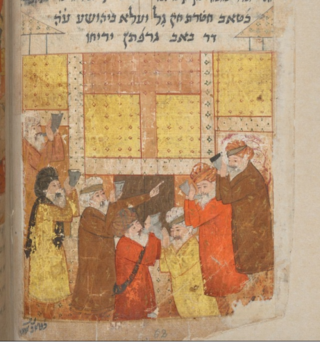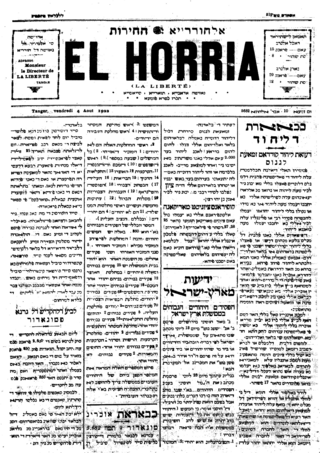Related Research Articles

Judeo-Persian refers to both a group of Jewish dialects spoken by the Jews living in Iran and Judeo-Persian texts. As a collective term, Judeo-Persian refers to a number of Judeo-Iranian languages spoken by Jewish communities throughout the formerly extensive Persian Empire, including the Mountain and Bukharan Jewish communities.

Jewish languages are the various languages and dialects that developed in Jewish communities in the diaspora. The original Jewish language is Hebrew, supplanted as the primary vernacular by Aramaic following the Babylonian exile. Jewish languages feature a syncretism of Hebrew and Judeo-Aramaic with the languages of the local non-Jewish population.

Judeo-Arabic dialects are ethnolects formerly spoken by Jews throughout the Arab world. Under the ISO 639 international standard for language codes, Judeo-Arabic is classified as a macrolanguage under the code jrb, encompassing four languages: Judeo-Moroccan Arabic (aju), Judeo-Yemeni Arabic (jye), Judeo-Egyptian Arabic (yhd), and Judeo-Tripolitanian Arabic (yud).

Judeo-Berber or Judeo-Amazigh is any of several hybrid Berber varieties traditionally spoken as a second language in Berber Jewish communities of central and southern Morocco, and perhaps earlier in Algeria. Judeo-Berber is a contact language; the first language of speakers was Judeo-Arabic. Speakers immigrated to Israel in the 1950s and 1960s. While mutually comprehensible with the Tamazight spoken by most inhabitants of the area, these varieties are distinguished by the use of Hebrew loanwords and the pronunciation of š as s.
Judeo-Italian is an endangered Jewish language, with only about 200 speakers in Italy and 250 total speakers today. The language is one of the Italian languages and one of the Jewish Romance Languages. Some words have Italian prefixes and suffixes added to Hebrew words as well as Aramaic, roots. All of the language's dialects except one are now extinct.
Yevanic, also known as Judaeo-Greek, Romaniyot, Romaniote, and Yevanitika, is a Greek dialect formerly used by the Romaniotes and by the Constantinopolitan Karaites. The Romaniotes are a group of Greek Jews whose presence in the Levant is documented since the Byzantine period. Its linguistic lineage stems from the Jewish Koine spoken primarily by Hellenistic Jews throughout the region, and includes Hebrew and Aramaic elements. It was mutually intelligible with the Greek dialects of the Christian population. The Romaniotes used the Hebrew alphabet to write Greek and Yevanic texts. Judaeo-Greek has had in its history different spoken variants depending on different eras, geographical and sociocultural backgrounds. The oldest Modern Greek text was found in the Cairo Geniza and is actually a Jewish translation of the Book of Ecclesiastes (Kohelet).

The Jewish Neo-Aramaic dialect of Zakho is a dialect of Northeastern Neo-Aramaic originally spoken by Jews in Zakho, Iraq. Following the exodus of Jews from the Muslim lands, most speakers now live in Israel, principally Jerusalem and surrounding villages.

Bukharian is a Judeo-Persian dialect historically spoken by the Bukharan Jews of Central Asia. It is a Jewish dialect derived from—and largely mutually intelligible with—the Tajik branch of the Persian language.

Judeo-Malayalam is the traditional language of the Cochin Jews, from Kerala, in southern India, spoken today by a few dozens of people in Israel and by probably fewer than 25 in India.
Judeo-Provençal, Judæo-Occitan or Judæo-Comtadin, are the names given to the varieties of Occitan or Provençal languages historically spoken and/or written by Jews in the South of France, and more specifically in the Comtat Venaissin area.
Judaeo-Romance languages are Jewish languages derived from Romance languages, spoken by various Jewish communities originating in regions where Romance languages predominate, and altered to such an extent to gain recognition as languages in their own right. The status of many Judaeo-Romance languages is controversial as, despite manuscripts preserving transcriptions of Romance languages using the Hebrew alphabet, there is often little-to-no evidence that these "dialects" were actually spoken by Jews living in the various European nations.
Judaeo-Catalan, also called Catalanic or Qatalanit, was a presumed Jewish language spoken by the Jews in Northern Catalonia and what is today Northeastern Spain, especially in Catalonia, Valencia and the Balearic Islands.
Baghdad Jewish Arabic or autonymhaki mal yihud or el-haki malna is the variety of Arabic spoken by the Jews of Baghdad and other towns of Lower Mesopotamia in Iraq. This dialect differs from the North Mesopotamian Arabic spoken by Jews in Upper Mesopotamian cities such as Mosul and Anah. Baghdadi and Northern Mesopotamian are subvarieties of Judeo-Iraqi Arabic.

Judeo-Moroccan Arabic is the variety or the varieties of the Moroccan vernacular Arabic spoken by Jews living or formerly living in Morocco. Historically, the majority of Moroccan Jews spoke Moroccan vernacular Arabic, or Darija, as their first language, even in Amazigh areas, which was facilitated by their literacy in Hebrew script. The Darija spoken by Moroccan Jews, which they referred to as al-‘arabiya diyalna as opposed to ‘arabiya diyal l-məslimīn, typically had distinct features, such as š>s and ž>z "lisping," some lexical borrowings from Hebrew, and in some regions Hispanic features from the migration of Sephardi Jews following the Alhambra Decree. The Jewish dialects of Darija spoken in different parts of Morocco had more in common with the local Moroccan Arabic dialects than they did with each other.
Judeo-Tripolitanian Arabic is a variety of Arabic spoken by Jews formerly living in Libya.
Judeo-Tunisian Arabic, also known as Judeo-Tunisian, is a variety of Tunisian Arabic mainly spoken by Jews living or formerly living in Tunisia. Speakers are older adults, and the younger generation has only a passive knowledge of the language.
Paul Wexler is an American-born Israeli linguist, and Professor Emeritus of linguistics at Tel Aviv University. His research fields include historical linguistics, bilingualism, Slavic linguistics, creole linguistics, Romani and Jewish languages.

Joseph (Yossi)Chetrit is Emeritus Professor of the French language and literature department and the Hebrew language department at the University of Haifa, former head of the Centre for the Study of Jewish Culture in Spain and Muslim Countries, and founder of the Tsfon-Maarav Troupe.
Judeo-Gascon is a sociolect of the Gascon language, formerly spoken among the Spanish and Portuguese Jews who settled during the 16th century in the cities of Bordeaux, Bayonne and in the south-west part of Landes of Gascony (most notably in Peyrehorade and Bidache. Judeo-Gascon, as Judeo-Provençal, the other major Jewish sociolect of Occitan, is now practically extinct.
The Jewish community of Constantine dates back to the 2nd century AD though legends say it goes back the second temple period. The Jewish community of Constantine thrived under Muslim rule and reached prominence from the 15th to 18th centuries, with several prominent figures and a Jewish quarter. After French colonization in 1837 and citizenship grants in 1870, tensions between Muslims and Jews led to the 1934 Constantine riots. After Algerian gained independence in 1962, most Jews left for France due to Francophilia and a lack of Zionism, leaving only a few families by the late 1960s. Rabbi Yosef ben David Renassia's preservation efforts ensured the legacy of Constantine's Jewish heritage through religious texts and language preservation.
References
- 1 2 3 4 Tirosh-Becker, Ofra (January 20, 2024). "Linguistic analysis of an Algerian Judeo-Arabic text from the 19th century". La Linguistique: 193–212. doi:10.3917/ling.55.0193. S2CID 198036565 . Retrieved January 20, 2024.
- 1 2 Tirosh-Becker, Ofra (2011-01-01). "On Dialectal Roots in Judeo-Arabic Texts from Constantine (East Algeria)". Revue des Études Juives: 227.
- 1 2 3 4 5 Tirosh-Becker, Ofra (2022-12-14). "Part-of-Speech and Morphological Tagging of Algerian Judeo-Arabic". Northern European Journal of Language Technology: 2 – via Academia.edu.
- 1 2 3 Tirosh-Becker, Ofra (2022-01-01). "TAJA Corpus: Linguistically Tagged Written Algerian Judeo-Arabic Corpus". Journal of Jewish Languages: 25 – via Academia.edu.
- ↑ Yoda, Sumikazu (2005). The Arabic Dialect of the Jews in Tripoli (Libya): Grammar, Text and Glossary. Otto Harrassowitz Verlag. p. 31. ISBN 978-3-447-05133-0.
- 1 2 Tirosh-Becker, Ofra (2019). "Linguistic analysis of an algerian judeo-arabic text from the 19th century". La Linguistique (in French). 55 (1): 193–212. doi:10.3917/ling.55.0193. ISSN 0075-966X. S2CID 198036565.
- ↑ Tirosh-Becker, Ofra (2019). LINGUISTIC ANALYSIS OF AN ALGERIAN JUDEO-ARABIC TEXT FROM THE 19TH CENTURY. Presses Universitaires de France. p. 196. ISBN 9782130821465.
- 1 2 "LINGUISTIC ANALYSIS OF AN ALGERIAN JUDEO-ARABIC TEXT FROM THE 19TH CENTURY" (PDF). Presses Universitaires de France : 12 – via scholars.huji.ac.il.